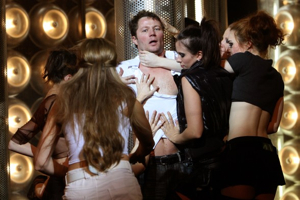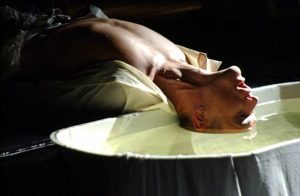There are a number of anxieties in advance of the General Election on February 25th, not least the worry that we will just get more of the same, but few Irish artists will be anxiously watching the ballot boxes fearing the impact of the new government on Arts Council decision-making, and the Director of the Abbey Theatre will not be wondering whether to get his coat. Yes, budget amounts may be affected by who gets into power and the value they attach to the arts – but it is unlikely that artistic directors of theatres and arts centres around the country will get the boot, or that a unilateral brake will be put on funding for independent theatre companies.
In Hungary, it is otherwise. Following a general election in May 2010, which saw the national conservative party Fidesz-KDNP gain power from the Socialist-left (MSZP) with a decisive two-thirds majority, there have been serious reverberations across the theatre sector. Although the Hungarian theatre scene has always been influenced by politics, now this has become more overt: the gloves are off. Funding awards previously made to the independent theatres have been blocked, and legislation which guaranteed that six per cent of state theatre funding would go to independents is now set to be revoked.
“Independent” theatre companies are generally those that are not attached to a theatre building. With relatively low overheads, they can be mobile and innovative, staging work in new ways and new spaces, and frequently representing Hungarian theatre arts on the international stage. “Official” theatres are the physical structures with resident companies, owned and supported by the local town or city council – and in post-communist Hungary, this means most theatres. (Of the two companies that travelled to Ireland as part of the Ulster Bank Dublin Theatre Festival in 2007, the now semi-disbanded Krétakör falls into the independent category; Katona József Theatre, which is supported mainly by the city of Budapest, does not.)
For “official” theatres, the relationship with the local mayor, on whom their funding depends, has always been critical – but where before councils generally went on the recommendations of the company itself or a panel of experts, it now seems that the artistic director has become a political appointment, with those perceived as “belonging” to the previous government gradually being replaced by new faces and new names. From one perspective this could be viewed as healthy – in his (apolitical) 2008 manifesto, Notes of an Escapologist, Krétakör's director, Árpád Schilling, called for an entire overhaul of the “theatre elite” to renew Hungarian theatre – but in practice this renewal so far seems to be just about one regime replacing the last.
So much for the idyllic idea that a theatre can belong to the local district or town; it seems, rather, that theatres belong to one side or the other of the political divide. What is at root, of course, is the universal struggle over power and resources, and two sides that both feel hard done by and suspicious of the other. And in this, it could be argued, Hungarian theatre is accurately reflecting the mood of wider Hungarian society.
This narrative is now being overtaken by questions about what exactly constitutes Hungarian culture and “Hungarian values”, with new political attention being brought to those artistic platforms that might be considered representative of national identity. Here the same divide exists, with more traditional arts emphasised by right-leaning groups and liberal arts associated with the left (a perception compounded by three coalition governments between the Socialists and the Liberals in the 1990s and 2000’s). The recent debacle over the position of artistic director of the National Theatre is illustrative.
 The first rumbles came in the parliament on 22 November, when a member of the far-right Jobbik (“the Movement for a Better Hungary/ Hungary for the Hungarians”) party asked the parliamentary secretary of the Ministry of Natural Resources, which now includes the portfolio of culture, for how long they should “tolerate” the current artistic director of the National Theatre, Róbert Alföldi. Referring to a season programme that, he claimed, did not represent national culture or tradition - “sick shows” which included “homesexual scenes”, and “rape of children”. Worst of all was the presentation of the Hungarian canon in an “interpretation” that “could not be tolerated". The Deputy Minister expressed sympathy with the Jobbik member's position and responded that since the terms of the previous government's appointees were coming to an end, it was just a matter of time before the issue of the National Theatre would be resolved.
The first rumbles came in the parliament on 22 November, when a member of the far-right Jobbik (“the Movement for a Better Hungary/ Hungary for the Hungarians”) party asked the parliamentary secretary of the Ministry of Natural Resources, which now includes the portfolio of culture, for how long they should “tolerate” the current artistic director of the National Theatre, Róbert Alföldi. Referring to a season programme that, he claimed, did not represent national culture or tradition - “sick shows” which included “homesexual scenes”, and “rape of children”. Worst of all was the presentation of the Hungarian canon in an “interpretation” that “could not be tolerated". The Deputy Minister expressed sympathy with the Jobbik member's position and responded that since the terms of the previous government's appointees were coming to an end, it was just a matter of time before the issue of the National Theatre would be resolved.
 It is generally agreed within the theatre community that since he took up the role of director in 2008, Alföldi has reinvigorated the National Theatre, transforming it into an innovative, inspiring centre of Hungarian theatre, where experimental risk-taking takes precedence over the staging of museum pieces – but the work can be shocking for those seeking a pleasant night out at the theatre.
It is generally agreed within the theatre community that since he took up the role of director in 2008, Alföldi has reinvigorated the National Theatre, transforming it into an innovative, inspiring centre of Hungarian theatre, where experimental risk-taking takes precedence over the staging of museum pieces – but the work can be shocking for those seeking a pleasant night out at the theatre.
However, prior to November 22nd, in what was an extremely ill-judged move, Alföldi had agreed with Romanian embassy officials that they could host an event in the National Theatre on their national holiday, December 1st. This particular holiday celebrates the unification of provinces with Romania, including Transylvania – among the most contentious of Hungary’s territorial losses following the first World War, and the subject of much sore feeling today. (The Treaty of Trianon, in which Hungary lost two-thirds of its pre-war territory, was dramatic.) When challenged on this, Alföldi withdrew his agreement, the event did not take place in the National Theatre, and Alföldi issued a statement that it had been a mistake, and he apologised for hurting his compatriots. It remains extraordinary that Alföldi would have entered such an agreement, given his less than secure position in the theatre.
On December 1st, when the event should have taken place, a showdown took place on the banks of the Danube. Around fifty supporters of the Jobbik party assembled, with their flags, in front of the National Theatre to demand Alföldi's immediate departure from the theatre, with particular emphasis on his sexual orientation. The protestors faced down by a band of well-known actors and critics – not all of whom would necessarily be fans of his stage work – who came out in support of Alföldi as an officially appointed leader of the theatre, with two years remaining in his term. (It should be noted that Alföldi's appointment, during the last (Socialist) government was by way of an open competition – but 'open' in the way that it was widely known he would get the position.)
Among the evidence put forward by the anti-Alföldi demonstrators was Alföldi's direction of János Vítéz (John the Valiant) on the national stage. Based on a Hungarian folktale, there have been many versions but that of Hungary’s national poet and hero of the 1848 revolution, Sándor Petőfi, is the most well-known. Alföldi's production, using a different version, represents the hero's arrival at fairyland as a descent into an underground world populated by prostitutes, including the heroine, Iluska. The protestors expressed outrage at such an interpretation of a Hungarian classic. However, they seemed unsure of the heroine's name or of the version presented in the theatre; this inaccuracy was seized upon by the left-leaning/liberal commentators as support of their opinion that the protestors had little or no experience of theatre at all, and were therefore ill-equipped to judge.
Next, there were loud whispers in the wings that Alföldi was to be ousted mid-way through his term, and that artistic director of Csokonai Színház theatre in the town of Debrecen, Attila Vidnyánszky, was to be instated. In November 2008, Vidnyánszky had founded the Magyar Teátrumi Társaság – an alliance of right-leaning theatre companies, as a splinter group from the main theatre association, established to fight back against a perceived bias towards the Socialists. His politics are very clear. To replace Alföldi, appointed during the Socialist government's term, with Vidnyánszky would have been a symbolic gesture.
 What does not seem to be in any doubt is Vidnyánszky's reputation as one of the best theatre directors in Hungary today. His direction of Ferenc Juhász's Szarvassá változott fiú (The Boy Who Became a Deer) is considered a work of genius. Ironically, Vidnyánszky has a reputation for radical interpretation – his Waiting for Godot featured a female Gogo; his Three Sisters opened at the third act, then continued with the first. This is perhaps why the theatre community was astonished when Vidnyánszky decried Alföldi's direction of János Vítéz as not a “fair” interpretation, declaring that art should not interfere with the ethos of Petőfi's work (also mistaking the version performed). This seemed very much at odds with Vidnyánszky's artistic freedom.
What does not seem to be in any doubt is Vidnyánszky's reputation as one of the best theatre directors in Hungary today. His direction of Ferenc Juhász's Szarvassá változott fiú (The Boy Who Became a Deer) is considered a work of genius. Ironically, Vidnyánszky has a reputation for radical interpretation – his Waiting for Godot featured a female Gogo; his Three Sisters opened at the third act, then continued with the first. This is perhaps why the theatre community was astonished when Vidnyánszky decried Alföldi's direction of János Vítéz as not a “fair” interpretation, declaring that art should not interfere with the ethos of Petőfi's work (also mistaking the version performed). This seemed very much at odds with Vidnyánszky's artistic freedom.
With emotions now very heightened, last month one of Hungary's leading critics, Tamás Koltai, wrote an open letter in ÉS (Élet és Irodalom, a weekly critical newspaper) beseeching Vidnyánszky not to participate in politics this way, not to interfere in aesthetic judgments, as this level of activity was simply beneath him.
 And then last week, two things happened: Vidnyánszky premiered a new production in Debrecen, Ludas Matyi (Matt the Goose-boy) – another well-known Hungarian folktale – in which the geese have been replaced by women, thus altering the meaning entirely when Matt goes down to the market to sell his wares. The politicians from the Jobbik party – who by now have become avid theatre-goers – were incensed. And a couple of days later, Alföldi announced next season's programme at the National Theatre, which would indicate that he is to see out his term after all.
And then last week, two things happened: Vidnyánszky premiered a new production in Debrecen, Ludas Matyi (Matt the Goose-boy) – another well-known Hungarian folktale – in which the geese have been replaced by women, thus altering the meaning entirely when Matt goes down to the market to sell his wares. The politicians from the Jobbik party – who by now have become avid theatre-goers – were incensed. And a couple of days later, Alföldi announced next season's programme at the National Theatre, which would indicate that he is to see out his term after all.
It now appears that the politicians might be in retreat, having realised that theatre is a slippery platform and that it might be better to leave it to those who understand it best. Nevertheless, the plight of the independent theatres is ongoing, and artistic directors of theatres around Hungary continue to be replaced when their terms come to an end. Taken with a highly controversial media law and threats to freedom of the press, we are reminded that Hungarian democracy is new and fragile – few want to return to the days of clandestine performances in apartments and basements, romantic notions only when viewed from afar.
It's difficult to imagine a similar scenario here today, but think back to the early years of the new Irish republic and the environment wasn't so vastly different. Today, when the manifesto of the National Campaign for the Arts talks about the role of the arts in cultural tourism and in the “identity of communities and regions”, we should recognise that it does this within a framework of rare freedom; in another political climate, concepts such as Brand Ireland and even Culture Ireland might mean something else entirely. We may be anxiously watching budgets in 2011, but at least excellence in the arts is – currently – paramount to the Ireland we want to project. Irish politicians are unlikely to interfere in this.
Fíona Ní Chinnéide is Reviews Editor of Irish Theatre Magazine and lived in Budapest from 2005-2008.